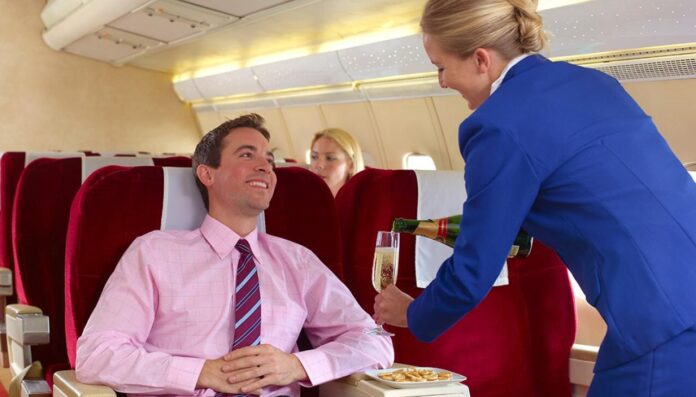Who has the right to the middle armrest?
Major jokingly describes the scramble for the middle armrest as a “brutal fight,” but comes down firmly on the position that the person in the middle should take it.
Malis agrees: “It’s not written down anywhere as far as I’m aware, but I think the unspoken courtesy is that the person in the centre seat, in the middle seat, gets the armrest.”
Should window blinds be kept closed or open?
Some people want them up, some people want them down. Major says window blinds can be a contentious issue, particularly on long-haul flights, but the answer is often pretty clear.
“If it’s a night flight, close them,” says Major. “Just one person opening the blinds, the light comes in and keeps people awake and it can really have an impact on people. You understand it though – people want to have a look down. If you’re flying over the Himalayas, you want to have a look at Mount Everest. Why would you not?”
Blinds also need to be open upon arrival due to safety regulations, much to the annoyance of some sleepy passengers. Major says if travellers push back, he’ll try to explain that the crew needs to be able to see out to adjust to the light in case there are any problems.
“I think I think people deal with an explanation an awful lot better than an order,” he says. “An explanation – it gives some mutual respect.”
How do you cope with being on your feet all day?
Working as a flight attendant is a physically demanding job. Flying long or short haul, you can be on your feet for hours.
“I’ve got insoles in my shoes,” says Major, adding it’s harder for female flight attendants, who are sometimes expected to wear heels.
Those who can will pick the comfiest smart shoes possible, says Major, who says Doc Martens are a popular choice.
Malis says high heels, “definitely add another strain to our feet,” but some flight attendants have inflight shoes they change into, which are more comfortable.
“It’s definitely a job where you get some good steps in. I think standing is almost just as exhausting as walking though, it can be hard on the lower back,” she says.
What do you do in your downtime on flights?
Ultra long-haul flights include structured rest periods for cabin crew. Flight attendants will retire to a separate area of the airplane during this downtime. Facilities vary depending on the airline, route and aircraft.
“Some have beds, some are just comfortable seats in remote places on the aircraft,” says Major. “What facilities they offer will depend on how much rest you’re supposed to have – and then how much work you can do is based on that.”
Still, it’s not always easy to sleep on a plane – even if you’re a flight attendant and you need to recharge before getting back to work.
“I know crew that don’t, and they’ll read a book or watch a movie on their iPad or something,” says Major.
Major says flight attendants working on low-cost carriers sometimes have more downtime on board, as they don’t serve much in the way of food and drink. Cabin crew might try to make the most of those pauses.
“A lot of people do higher educational courses, they use the downtime in hotels and places like that, and even on the flights, to do the work,” he says.
Malis says she rarely has time to herself on her domestic US flights. If she does, she’ll eat a quick snack to refuel.
Do flight attendants eat and drink the same food as passengers?
Malis and Major say flight attendants are able to eat and drink airline culinary offerings, but may choose not.
“Airplane options aren’t always the foods that are going to keep me the most alert,” says Malis, who says she usually packs light snacks like hummus, apples and popcorn.
“I drink plenty of airplane coffee I will say, but I usually bring my own – at least have one on my way to work or at the airport that’s a little stronger – and sip on that all morning long.”
Major says he avoids foods that might make him feel bloated. His main focus is drinking lots of water on board.
“You’ll always find the crew have got a bottle of water and a hot drink somewhere, they’ll have a tea or coffee.”
Major says some crew will also bring their own meals on board, often due to dietary requirements, but his airline doesn’t allow crew to heat up food from home in the inflight ovens.
Malis says her airline does – in theory – allow flight attendants to heat up food brought from home, but you have to bring the right container and ovens can be unpredictable when you’re trying to get the temperature right.
On holiday flights, Malis says some crew members might get creative, bringing in food to add to the festive vibe and “to cheer the crew up if they’re missing out on spending the day with their family.”
“There’s some pretty clever little things that flight attendants can do in the galley,” she adds. “But for the most part, there’s not a lot of time to be doing that. Mostly flight attendants are just trying to find any spare moments to grab a bite of food to keep going on some of these marathon days.”
How do you deal with nervous fliers?
For some passengers, it’s the fact they’re not in control. Other travellers hate the unidentified noises that soundtrack the flight.
“When I find someone who’s scared of flying, I try to find out what’s the driver behind it,” says Major. “If you can talk to people and find out why they’re frightened, then you can alleviate their fears, because the chances of anything mechanical creating a situation where the plane would crash – it’s beyond remote.”
Some people find learning more about the mechanics and logistics helpful. Other passengers just need distraction, and speaking to flight attendants might help.
“The crew, that’s down to their skills to find out what it is that person needs to get them through the flight,” says Major.
If Major is speaking to an anxious passenger before the aircraft takes off, there’s also another layer at play – flight attendants want to avoid someone deciding to deplane at the last minute, which could delay the flight and mean the aircraft misses its takeoff slot.
Major and his team have to decide as quickly as possible whether the passenger is able to fly that day.
“That again, comes down to the skills of the crew,” says Major, who will always strive to remain calm in those moments. “I don’t want the passengers to think my primary concern is, ‘Are you going to delay me closing the doors and getting this thing up in the air?'”
Malis advises that anxious fliers make themselves known to air crew. If she knows a passenger is nervous, she’ll try to keep tabs on them for the duration of the flight. She recommends breathing techniques, and also advises bringing along an engrossing book, or losing yourself in a TV show or movie.
Major also advises bringing an iPad, colouring books or toys to entertain children and keep them as calm as possible during the flight.










